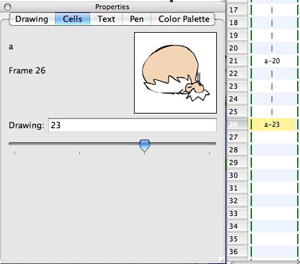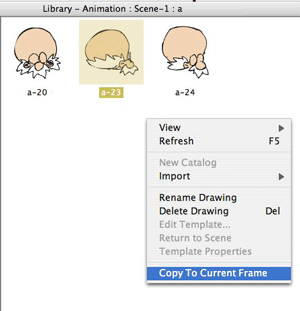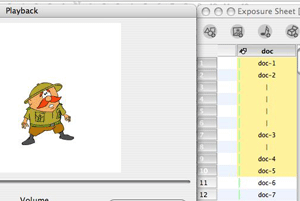Miscellaneous TBS UsageTips
TBS Help in your personal browser
I absolutely love the TBS help system, it is easily one of the best implementations of a help system ever. The keyword search is outstanding and if you aren't using it, you are cheating yourself out of a great resource.
Now one complaint I use to have about the TBS help system was that it works in my web browser which used to be Internet Explorer and it was a pain in the neck to have to answer that annoying IE question about allowing the display of an "Active X Object" or whatever. When IE 7.0 came out, I really hated it. So I switched to Firefox which I really like. (just a personal preference) But I didn't know how to tell TBS to use Firefox instead of IE for displaying the help system. Actually it is super easy. You just set Firefox up as your default browser in Windows for your system and guess what? TBS help is always displayed in the default system browser. Problem solved.
Flipping
Many animators like to "flip" their drawings to check out how an action is progressing. There is a little talked about trick in TBS that is a great "flipping" substitute. If you highlight a sequence of cells in an element in your exposure sheet or on the time line and then press the Shift + Enter key, TBS will just render that sequence of cells and by using the "loop" button on the render viewer, you can watch them flip over and over and see how the action is looking. This is much nicer than trying to use the A and S keys to flip through a sequence. It is a really fast way to flip through any sequence of cells you select. One more of those little animator friendly features in Toon Boom Studio.
Inking in Thick and Thin Lines
One of the often asked questions in forums about 2D animation pertains to line quality in drawings. Now it is important to distinguish between the lines in your initial animation work and the "inked lines" of your cleaned up finals. You shouldn't be overly focused on line quality (thicks and thins) when you are roughing out your animations, line quality presentation is part of the clean up inking phase not the rough drawing phase.
Once you have your animation drawn the way you want it, then you can do the clean up and inking usually on a separate cell in a separate drawing element in TBS. If line quality, thick and thin lines, to add depth and show volume and weight, are important to you, then you want to ink with the brush tool, using a tablet with pressure and tilt sensitivity turned on. In TBS you also want to set up your selected pen in the properties panel to have a range of minimum to maximum of at least 8-12 pixels. I usually work with my "inking" pen at 3 minimum and 36 maximum and smoothing at 3.
But here is the often missed trick to doing great thick and thin inked lines in the digital world. Don't expect to make the line in a single pass or stroke of the brush tool. Line thickness is built up by making multiple passes and letting the brush tool build thickness on top of your previous strokes. In TBS, when you are in Draw Top Layer mode, each brush stroke of the same color merges into the same color strokes below as they touch each other, which allows you to build up your strokes and make great thicks and thins. This technique is fast and with a bit of practice you will swear it is like using real ink. In TBS you want to be sure you have the Tools>Draw Top Layer function toggled on for clean up inking. When you ink your clean ups, focus on your Wacom pen as if you were applying real liquid ink with a fine brush and paint on the thicks and thins with several passes over the line.
Sometimes It Just Isn’t Working
Using keyed frames to animate in TBS is a great way to get the illusion of motion using fewer individual drawings. A few drawing when properly manipulated along with the camera can produce some very entertaining things. But sometimes after you have been working on making and adjusting a whole series of keyed frame actions you just aren’t happy with the results because it just isn’t working like you wanted it to move or the shot is just not right. We all have been there. Unfortunately by that time using the undo command is no longer a good option. Now one tip and a most useful command is to right click on that keyframe you just don’t like, being sure you have selected the appropriate scene planning tool to target the type of attribute you want to change, and from the context menu select remove keyframe. But sometimes you just get to the point where the more you change things the worse it gets. That’s when you want to use a different approach and select remove all keyframes. Yes, it seems a bit drastic but sometimes starting over clean is faster then trying to “patch up” a mess of keyed frame parameters out of control.
Toon Boom Studio has an excellent cell swapping function. For any drawing element you can use the Cells tab on the Properties panel to select and swap cells. You can use a slider to scan through all the cells of that element until you find the desired cell or you can enter a cell's name in the text box to select your cell. The selected cell is swapped in place of the current cell for the selected frame or range of frames in the time line.

As stated above the Properties panel Cells tab is great for doing cell swapping but, it has a couple of drawbacks that need to be observed. First, when you are on a specific frame and you scan through your existing element's cells, it automatically swaps the current cell in that frame for the cell that is visible in the Cells tab preview window. That's good and bad. Good because it is fast and bad because it loses track of the cell that was previously there and if you change your mind, you have to go and find that previous cell. If you have a large number of cells in your element the search process can be slow. Also if you created your cells using a fairly random numbering scheme then knowing where to look in the list, which is numerically ordered, is more difficult. But the swapping capabilities are excellent otherwise.
Here is a trick we use. Open the Library panel and navigate to Animation>Scene for your current scene and select the element you want to utilize. Then in the Library display window you can view all the cells for that element at once. Turn on the View>Thumbnails and you have a fast easy visual way to pick your desired cell. Then when you go to the Cells tab of the Properties window you just type in the cell number of that cell to place it on your desired frame or frame range in the time line. This works extremely well for elements which contain more than a few cells.

Or an even easier way is to use the copy to current frame context menu command directly from the Library display window. Select the desired frame in the time line, select the desired cell in the Library display window, right clicking to open that context menu and select copy to current frame.
So for things like swapping mouth positions you can use the Cells tab on the Properties panel, or for general selecting and placing of cells for reuse the Library panel may be even easier.
Labels: Cell Swapping, Flipping Drawings, Inking, Key Framing, Library, TBS Help Browser, Tips




0 Comments:
Post a Comment
<< Home